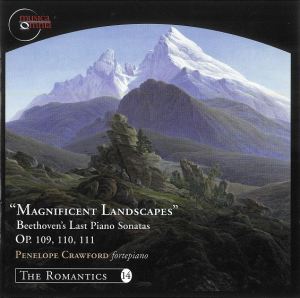 |
 |
|


alternatively
CD: AmazonUK
AmazonUS |
Ludwig van BEETHOVEN
(1770-1827)
Piano Sonata No. 30, Op. 109 in E major [19:20]
Piano Sonata No. 31, Op. 110 in A flat major [19:12]
Piano Sonata No. 32, Op. 111 in C minor [25:53]
 Penelope Crawford (fortepiano, Conrad Graf, 1835)
Penelope Crawford (fortepiano, Conrad Graf, 1835)
rec. 5-8 April 2010, First Presbyterian Church, Ypsilanti, Michigan,
USA
 MUSICA OMNIA MO0308 [64:25]
MUSICA OMNIA MO0308 [64:25] 
|
|
|
This has been a very good year for Beethoven piano sonata aficionados
who prefer the sound of the period pianoforte. Alexei
Lubimov’s idiosyncratic but mostly engaging account
of the final three sonatas appeared early in 2011, joining two
previous accounts of the last three well worth recommending:
Ronald Brautigam’s fast, fleet, comparatively ‘classical’
approach and Paul Komen’s warm, rich reading on the Globe
label. And now Penelope Crawford, maybe the leading American
fortepianist, weighs in with her interpretation - arguably the
best of all. It’s closest to Komen’s in its lyricism,
poetic demeanor, and spiritualism. I wouldn’t want to
miss any of Crawford, Komen, or Brautigam, but then I’m
mad about this music.
Penelope Crawford actually jumps into Op. 109 with abandon and
virtuosity, and there is not much relenting in the drama or
the fine percussive attack of the Conrad Graf 1835 instrument
until the slow movement unfolds over thirteen expansive minutes.
A few of the variations here really do have the healing magic
that distinguishes the very best performances: just listen to
the extraordinary muted tones of the Graf instrument at around
7:25. Op. 110 follows a similar pattern: there is no short-changing
any of the moods Beethoven strikes, nor an attempt to homogenize
them; if Crawford has a leg up on the speedy Brautigam or the
warm Komen, it is that her approach to the music cannot always
be packed up in a single adjective. The fugal sections of the
work are played with a Bach-like coolness and objectivity which
melt away in the adagios (the transition from 5:40-5:55 is masterfully
done), and in the triumphant final climax.
The final sonata lacks, in its opening pages, the extra savagery
which is so compelling in Brautigam’s reading; one misses
the fiery drama which can tie the first movement to the mood
of Beethoven’s past struggles in C minor. But the arietta
is something altogether different, and here Crawford offers
as lucid and transcendent a reading as you can hear anywhere.
I’ve long felt that the fortepiano sound is irreplaceable
in some of the variations of the movement: they still sound
alien on a modern concert grand, but they are really daring,
especially magical on the more alien variations at the topmost
registers of the instrument. If you know the sonata only from
performances on a Steinway, you’ll know there are variations
of somewhat mystical, esoteric tinkling: but on this instrument,
with its extraordinary muted sonorities, those passages sound
dangerous, new, startling, and chillingly beautiful.
Even setting performance aside it’s an attractive package:
the sound is ideally welcoming, the pianoforte a marvelous warm
instrument (as mentioned) tuned as scholars estimate the keys
would have been tuned at the time, and the booklet essay, by
Jeremiah McGrann, is really an outstanding (and in-depth at
14 pages) look at these works. I prefer my Opp. 109-111 to be
spiritual exercises, and in the first two it hardly gets better
than Gilels/DG for me; Penelope Crawford comes from this tradition
and she is a rare fortepianist who could stand up to direct
comparison to Gilels or Pollini. She is clearly a major artist
able to find both classical backbone and poetic blood in the
lives of these works, and the Graf instrument is one of the
best to ever be deployed in these sonatas.
When I got this disc for review, I was still working on a write-up
of Alexei Lubimov’s disc, covering the same sonatas and
on an Aloiss Graf instrument; I thought, “oh, no, not
another one”. My reaction would have been much different
had I known. This disc is special.
Brian Reinhart
|
|

